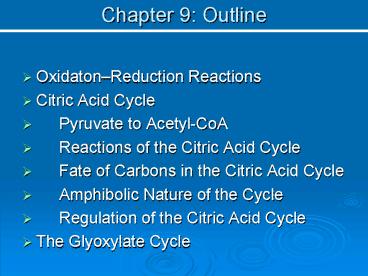Chapter 9: Outline PowerPoint PPT Presentation
1 / 28
Title: Chapter 9: Outline
1
Chapter 9 Outline
- OxidatonReduction Reactions
- Citric Acid Cycle
- Pyruvate to Acetyl-CoA
- Reactions of the Citric Acid Cycle
- Fate of Carbons in the Citric Acid Cycle
- Amphibolic Nature of the Cycle
- Regulation of the Citric Acid Cycle
- The Glyoxylate Cycle
2
Introduction
- Facultative anerobes and obligate aerobes use
oxygen to generate energy. - The oxidation uses the citric acid cycle, the
electron transport chain, and oxidative
phosphorylation to pass electrons to dioxygen via
NADH and FADH2. - In eukaryotic cells, oxidation occurs in the
mitochondria.
3
9.1 Oxidation-Reduction
- Oxidation occurs when a substance loses
electrons reduction when a substance gains
electrons. Eg. - Cu(aq) Fe3(aq)? Cu2(aq) Fe2(aq)
- Cu oxidized Cu ? Cu2 1e-
- copper loses an electron
- Fe reduced Fe3 1e- ? Fe2
- iron gains an electron
4
Oxidation-Reduction-2
- The tendency for a species to gain electrons is
its reduction potential. - Standard reduction potentials are measured in an
electrochemical cell vs a standard hydrogen
electrode where H2 is 1 atm and H 1.0 M. - The measured voltage for the Cu/Fe3 couple is
0.61 volts. (Next slide.)
5
Oxidation-Reduction-4
- The standard reduction potential for hydrogen
under physiological conditions is 0.42 v. - Electrons flow spontaneously from a species with
a more negative E0 value to a species with a
more positive E0 value.
6
Oxidation-Reduction-5
7
Oxidation-Reduction 6
- Biological oxidation of carbohydrates supplies
the body with its major energy needs. - The electrons lost are eventually transferred to
dioxygen (O2) to produce water. - Biologically, oxidation is usually the addition
of oxygen or the removal of two hydrogen from a
molecule. Reduction is the reverse.
8
Oxidation-Reduction 7
- An example of a biological redox system
NADH is reducing agent
pyruvate is reduced
9
Pyruvate Decarboxylate Complex
pyruvate
Acetyl CoA
10
Decarboxylation
11
PDC Continue
12
PDC The Multienzyme Complex
- The pyruvate dehydrogenase complex is probably
arranged in a compact cubic arrangement with each
enzyme present as dimeric or trimeric complexes. - The lipoic acid is covalently attached to the
transacetylase enzyme via a lysine residue. The
acid and the lysine act as a swinging arm which
moves to the site of the reactions. (Next slide)
13
PDC The Swinging Arm
14
9.2 The Citric Acid Cycle
- Acetyl CoA and oxaloacetate feed the citric acid
(TCA) cycle. - The acetyl group is oxidized to two molecules of
CO2 and high energy electrons are transferred to
NAD and FAD.
15
TCA Cycle
Now Recycle and ATP Produced
16
The TCA Cycle-1
H2O
Citrate
Oxaloacetate
CoA-SH H
Citrate synthase
17
The TCA Cycle-2
Citrate
Isocitrate
aconitase
18
The TCA Cycle-3
NAD NADH H
Mg2
CO2
H
a-ketoglutarate
Isocitrate
isocitrate dehydrogenase
19
The TCA Cycle-4
CoA-SH
CO2
NAD NADH H
Succinyl-CoA
a-ketoglutarate
a-ketoglutarate dehydrogenase complex
20
The TCA Cycle-5
CoA-SH
GTP
GDP
Pi
Succinate
Succinyl-CoA
succinyl-CoA synthetase
21
The TCA Cycle-6
FAD
FADH2
Fumarate
Succinate
succinate dehydrogenase
22
The TCA Cycle-7
H2O
Fumarate
L-Malate
fumarase
23
The TCA Cycle-8
NAD NADH H
Oxaloacetate
L-Malate
malate dehydrogenase
24
The Cycle is Amphibolic
25
Regulation of the Cycle-1
- Citrate synthase
- Inhibited by citrate, NADH, ATP, and
succinyl-CoA - Isocitrate dehydrogenase
- Inhibited by NADH, ATP
- Stimulated by NAD and ADP
- a-ketoglutarate dehydrogenase
- Inhibited by NADH, succinyl-CoA
- Stimulated by NAD and ADP
26
Regulation of the Cycle-2
- Pyruvate dehydrogenase and pyruvate carboxylase
outside the cycle are important in regulation. - If, for example, oxaloacetate concentration falls
(eg. a-ketoglutarate used in synthesis), Ac-CoA
accumulates and this activates pyruvate
carboxylase and inhibits pyruvate dehydrogenase.
27
The Glyoxylate Cycle-1
- Plants and some fungi, algae, protozoans, and
bacteria can use two-carbon compounds for growth. - (ethanol, acetate, acetyl-CoA)
- In plants the reaction occurs in the glyoxysomes.
- There are five reaction in the glyoxylate cycle.
The first two (synthesis of citrate and
isocitrate) are the same as with the TCA cycle
but with new enzymes.
28
The Glyoxylate Cycle-2
- Two molecules of Ac-CoA are used in the cycle.

